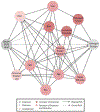Associations of exposure to perfluoroalkyl substances individually and in mixtures with persistent infections: Recent findings from NHANES 1999-2016
- PMID: 33578314
- PMCID: PMC7957906
- DOI: 10.1016/j.envpol.2021.116619
Associations of exposure to perfluoroalkyl substances individually and in mixtures with persistent infections: Recent findings from NHANES 1999-2016
Abstract
Certain viruses and parasites can cause persistent infections that often co-occur and have been associated with substantial morbidity and mortality. Separate lines of research indicate exposures to per- and polyfluoroalkyl substances (PFAS) suppress the immune system. We hypothesized that PFAS exposures might systematically increase susceptibility to persistent infections resulting in a higher pathogen burden. We used data from 8778 individuals (3189 adolescents, 5589 adults) in the nationally-representative U.S. National Health and Nutrition Examination Survey (NHANES) 1999-2016 to examine cross-sectional associations between serum concentrations of four highly detected PFAS (PFOS, PFOA, PFHxS, PFNA) with the presence of antibodies to cytomegalovirus, Epstein Barr virus, hepatitis C and E, herpes simplex 1 and 2, HIV, T. gondii, and Toxocara spp. Seropositivity was summed to calculate a pathogen burden score reflecting the total number of infections. Separate survey-weighted multivariable regression models were fitted to analyze PFAS individually and quantile g-computation was used to analyze PFAS mixtures. Among adolescents, 38.7% had at least one persistent infection while 14.9% had two or more; among adults, these percentages were 48.0% and 19.7%. Each PFAS was individually associated with significantly higher pathogen burdens and the most pronounced associations were observed in adolescents [e.g., among adolescents, a doubling of PFOS was associated with 30% (95% CI: 25-36%) higher pathogen burden]. Quantile g-computation revealed PFAS mixtures as a whole were also associated with higher pathogen burdens. Taken together, these results suggest PFAS exposure may increase susceptibility to and foster the clustering of persistent infections, particularly among adolescents. Since persistent infections are important contributors to long-term health, prospective data are needed to confirm these findings.
Keywords: Chemical mixtures; Infectious disease; PFAS; Pathogens.
Copyright © 2021 The Author(s). Published by Elsevier Ltd.. All rights reserved.
Conflict of interest statement
Declaration of competing interest The authors declare that they have no known competing financial interests or personal relationships that could have appeared to influence the work reported in this paper.
Figures



References
-
- Basic Information on PFAS, <https://www.epa.gov/pfas/basic-information-pfas> (
-
- Agency for Toxic Substances & Disease Registry. Toxicological Profile for Perfluoroalkyls. (2018). - PubMed
-
- NTP. Monograph on immunotoxicity associated with exposure to perfluorooctanoic acid or perfluorooctane sulfonate. (National Toxicology Program., 2016).
MeSH terms
Substances
Grants and funding
LinkOut - more resources
Full Text Sources
Other Literature Sources
Miscellaneous

